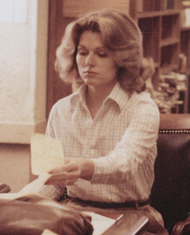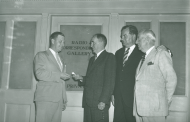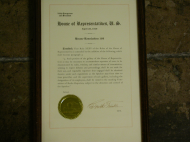Tina Tate
 Image courtesy of Tina Tate, provided by the Office of the Historian, U.S. House of Representatives
Image courtesy of Tina Tate, provided by the Office of the Historian, U.S. House of Representatives
— Tina Tate, July 12, 2007
Abstract & Transcript
Tina Tate’s recollections of her 34-year career in the House Radio-TV Gallery provide an invaluable window into the daily routine of a long-standing House institution. Created in 1939, the House Radio Gallery expanded to admit TV broadcasters in 1953. As only the third director in the gallery’s history, Tate witnessed major changes during her tenure, notably, rapid technological advancements in media broadcasting and the growing influence of television. Tate’s detailed account underscores her role as mediator between the House Leadership, which was determined to maintain the chamber’s decorum and rules, and broadcasters demanding access to cover important media events. The topics discussed in these interviews range from the House Radio-TV Gallery’s role in the coverage of Joint Sessions to major occurrences, including the 1998 shooting at the Capitol and two impeachments.
Biography
Ruth (Tina) Tate was born on September 5, 1944, in Atlanta, Georgia, to Clifford Holmes McGaughey, Sr., the owner of a sporting goods store, and Mary Elizabeth Barnes, a homemaker. After earning an A.A. degree from Stephens College in Columbia, Missouri, Tate graduated from Emory College in Atlanta with a B.A. in history. In 1966 she married Danny Clyde Tate, a lawyer; the couple raised one child, Daniel Clyde Tate, Jr. Tina Tate worked at the University of Georgia libraries while her husband was in law school and later took a job as a receptionist in Atlanta with Merrill Lynch, transferring to Washington, D.C., in September 1969, when her husband accepted a position with Georgia Senator Herman Talmadge. After working as an office manager at Cox Broadcasting from 1970 to 1972, Tate joined the House Radio-TV Gallery on July 15, 1972.
The first woman employed in the House Radio-TV Gallery, Tate served as an assistant superintendent for nine years before being promoted to director in October 1981. As director, Tate oversaw the daily operations of the House Radio-TV Gallery, where she facilitated coverage of House proceedings for radio and TV broadcasters. Her duties encompassed standard tasks, such as supervising the daily log of House proceedings for reporters, as well as more-complex responsibilities like coordinating radio and TV coverage of major media events such as Joint Sessions and Lying in State ceremonies. Tate also participated in national political conventions that spanned nearly two decades, credentialing broadcasters and allocating sky box, standup, and radio positions. Throughout her career, Tate strove to balance the needs of the gallery’s radio and TV broadcasters with the rules and traditions of the House.
Tate retired from the House on May 31, 2007. She served as the director of media relations at the Newseum in Washington, D.C., from July 2007 to July 2009. Tate and her husband reside in Washington, D.C.
Video
Background on Speaker's Press Conferences
Detailed history of the Speaker’s Press Conferences and ways in which the House Radio-TV Gallery assisted broadcasters in their coverage of Congress.
Members, Press, and the Radio-TV Gallery
Explanation of the role of the House Radio-TV Gallery in helping to keep the American public informed about the work of Congress.
Opening Day Traditions of a New Congress
Institutional role of the House Radio-TV Gallery in broadcasting the Opening Day of a new Congress.
Press Conferences in Statuary Hall after the State of the Union Address
Historical background on the technical requirements and logistical operations for the television coverage of Members’ responses in Statuary Hall following the State of the Union Address.
Return to the Capitol on September 11, 2001
Eyewitness account of the informal and symbolic gathering of Members of Congress on the Capitol steps in the aftermath of the September 11, 2001, terrorist attacks against the United States.
Audio
"Musical Desks" in the House Radio-TV Gallery
Description of the physical space of the House Radio-TV Gallery before the 1988 renovation.
Close Relationship Between the House Radio-TV Gallery and the House Parliamentarians
Insight on the relationship between the House Radio-TV Gallery and the House Parliamentarians, as well as the growing volume of information about the House available to staff and the press.
Effect of Televised Proceedings on the Reporting of Congress
Overview of the impact of live televised House proceedings on the reporting of Congress.
House Radio-TV Superintendents
Recollections of the first two superintendents of the House Radio-TV Gallery.
Live TV and its Impact on the House Radio-TV Gallery
Detailed explanation of how the evolution of the 24-hour news cycle changed the day-to-day operations of the House Radio-TV Gallery.
The House Radio-TV Gallery
Overview of the responsibilities of the House Radio-TV Gallery during the 1970s and 1980s.
Images & Artifacts
 /tiles/non-collection/o/oh_tate_gallery_opening.xml
/tiles/non-collection/o/oh_tate_gallery_opening.xml
 /tiles/non-collection/o/oh_tate_convention.xml
/tiles/non-collection/o/oh_tate_convention.xml
 /tiles/non-collection/o/oh_tate_michaelson.xml
/tiles/non-collection/o/oh_tate_michaelson.xml
 /tiles/non-collection/o/oh_tate_resolution.xml
/tiles/non-collection/o/oh_tate_resolution.xml
 /tiles/non-collection/o/oh_tate_cannon_rotunda.xml
/tiles/non-collection/o/oh_tate_cannon_rotunda.xml
 /tiles/non-collection/o/oh_tate_office.xml
/tiles/non-collection/o/oh_tate_office.xml











 ;
;
 ;
;
 ;
;
 ;
;
 ;
;
 ;
;